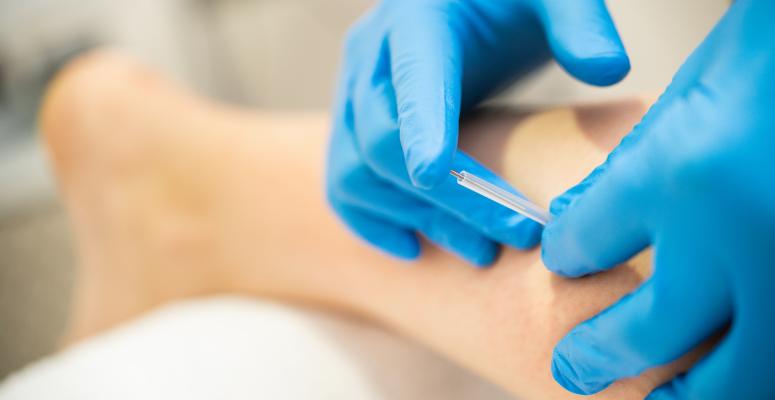
Dry needling may sound scary, but the reality is that it can be extremely effective. Dry needling is a professional technique primarily used by licensed physical therapists. Your physical therapist may recommend dry needling if you experience chronic muscle tightness or nerve entrapment symptoms. In addition, many physical therapy practices use dry needling to help ease pain and encourage blood flow to inflamed scar tissue. Studies have shown that dry needling techniques can ease scar tissue pain and inflammation.
Knowing the pros and cons of dry needling can help you decide whether it’s right for you.
What happens during a dry needling session?
During a dry needling session, a thin and sterile monofilament needle is inserted into your muscles or scar tissue. It is specifically pushed into your myofascial trigger points and surrounding tissue to reduce inflammation, relax tight muscles, and promote circulation. As the needles are placed in myofascial trigger points, the nearby muscles twitch in response. These spasms are what helps stiff muscles to loosen and blood flow to increase to the affected area.
Many people confuse dry needling with another practice known as acupuncture. While the two have similarities, they are not used for the same purpose and are not practiced by the same specialists. While acupuncture specialists rely on needling to promote balance, physical therapists use dry needling as a clinically proven way to relieve pain.
What does dry needling treat?
Your physical therapist can use dry needling to help treat a wide array of muscular conditions. Chronic pain patients can try dry needling to relieve their pain and fast-track healing. Some of the conditions that dry needling can treat include:
- Plantar fasciitis.
- Shoulder impingement.
- Tendinitis.
- Headaches and migraines.
- Tennis elbow.
What are the pros of dry needling?
Dry needling has several medical benefits and can boost your healing after an injury. Some of the many benefits of dry needling include:
- Pain relief — Dry needling can relieve temporary and acute pain and can also ease chronic, long-term pain. By targeting trigger points, dry needles are able to increase range of motion and reduce discomfort.
- Accessibility — Since dry needles are tiny and thin, they can easily target specific injured areas, like around the hands and feet. The needles can reach areas of the body that other treatment options could not as easily target.
- Supplemental benefits — Dry needling can be combined with other physical therapy treatments for maximum relief. Those treatments may include joint mobilization and strengthening exercises.
- Minimal invasiveness — Dry needling is less invasive than many other treatments. It also does not involve injections or medications.
- Efficiency — Dry needling sessions typically last 30 minutes, and they do not require any special preparation prior to the appointment. Patients can leave the clinic as soon as their dry needling treatment ends, saving them time and energy.
- Faster recovery — Dry needling can speed up patients' recovery time from injury and increase their range of motion by promoting blood flow around injured tissue.
What are the cons of dry needling?
While the pros of dry needling are numerous, the cons of dry needling are fairly minimal. You can consider the following cons if you are thinking about beginning dry needling treatments:
- Dry needling can cause discomfort during sessions.
While dry needling isn’t particularly painful, it can cause minor discomfort in the moment. This can be especially true at the beginning of your treatment, when your muscles are tight and inflamed. As your muscles loosen throughout sessions, you may experience less discomfort.
- Dry needling can cause muscle soreness for about 24 hours after treatment.
Your muscles can feel sore after they are stimulated by dry needles. This can be completely normal and a sign that the dry needling treatments are successfully stimulating your muscles.
- Dry needling can cause bruising or swelling.
Sometimes, bruising or swelling can occur around the area in which the needles were placed. Whether you bruise after your dry needling session depends on your skin type and its sensitivity level. In any case, bruising is most often temporary. - Dry needling can trigger allergic reactions.
If you have any allergies or sensitive skin, you should alert your physical therapist right away. Dry needling may cause your skin to become red or hot. Your therapist can work with you to decide whether to move forward with your dry needling treatment plan.
Alliance PTP is ready to help you find top-notch PT for dry needling
Are you curious as to what dry needling can do for you? At Alliance Physical Therapy Partners, we’re proudly bringing together physical therapy practices across the country to help people get the high-quality PT they need. Want to see a physical therapist in person? We can put you in touch with an Alliance PTP partner that’s close to you and that can help you find professional dry needling services.
Not keen on in-person PT sessions or not close to an Alliance PTP partner? No worries. We also offer effective and affordable virtual physical therapy through our Agile Virtual Physical Therapy platform.
Come find a physical therapist who can help you get the effective dry needling you need.
Get Help at a Location Near You
